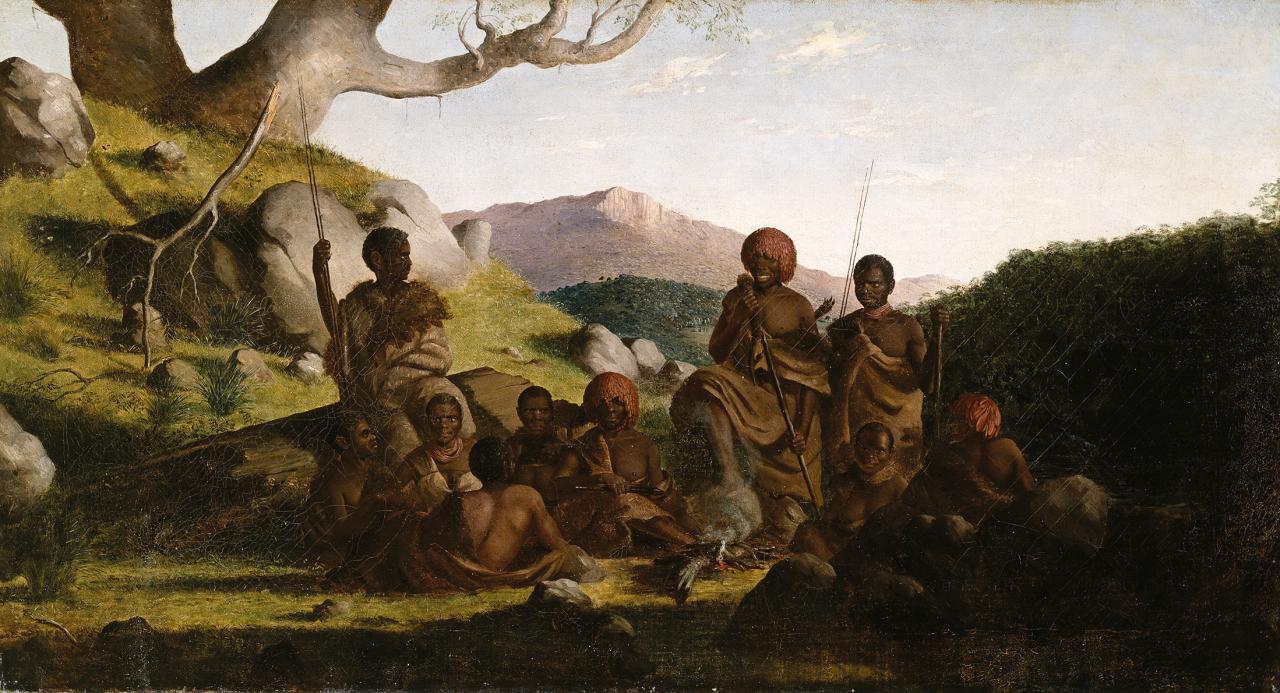Art History - S2 week 5 - 5/08/2019
Australia vs NZ Landscape
Different periods of conalisation, and art movements.
The most interesting thing about comparing the two is how the aborigine people are depicted compared to how Maori and pasicfica people are depicted.
As in austalira they are depicted in a way where they are helpless and white people are converting them into their culture as if they are helping them. Unlike NZ they are depicted in a more romantic way and fetishist way. It also shows their motives towards each place. As Australia paintings are more showing off how they are changing Australia and conalising it, unlike NZ where it is romaticaisted and exsotic making people want to go there. Australia depiction on people are also more romantic and non-factual, where NZ ones are factual and recording like.
Portrait artist
Donald Friend
Mike Parr

Depiction of indigenous people
European
https://www.ngv.vic.gov.au/essay/depictions-of-aboriginal-people-in-colonial-australian-art-settler-and-unsettling-narratives-in-the-works-of-robert-dowling/

"Dowling produced a number of portraits of Aboriginal people while living in Tasmania and in the Western District of Victoria during the 1850s. Masters George, William, and Miss Harriet Ware with the Aborigine Jamie Ware is a compelling image of interracial coexistence, a rarity in much nineteenth- and twentieth-century Australian art history. However, this apparently uncomplicated depiction of Aboriginal–European relations is strangely at odds with the world outside the painting."
Indigenous
https://www.artmarketmonitor.com/2009/07/17/a-key-to-aboriginal-culture/
"The drawing is the second-largest work created by Barak and of great relevance to Victorians — Barak was the head of the Wurundjeri people and the Coranderrk mission. Poignantly, he drew the corroboree on the back of a Christian poster listing the gospel readings for Holy Week. Although Barak adopted the Christian faith, he never relinquished his traditional culture and was an influential spokesman for the rights of his people. His drawings of sacred ceremonies and spiritual stories were important in helping non-indigenous people understand traditional Aboriginal ways. In 1895, Barak gave Corroboree to his friend Mrs G. M. Davies, who owned a property near Coranderrk, where he would often camp. The drawing was last sold by Sotheby’s in Sydney in 1998 for $74,000, more than double its lower estimate of $30,000. The estimate now is $180,000-$250,000."
Different periods of conalisation, and art movements.
The most interesting thing about comparing the two is how the aborigine people are depicted compared to how Maori and pasicfica people are depicted.
As in austalira they are depicted in a way where they are helpless and white people are converting them into their culture as if they are helping them. Unlike NZ they are depicted in a more romantic way and fetishist way. It also shows their motives towards each place. As Australia paintings are more showing off how they are changing Australia and conalising it, unlike NZ where it is romaticaisted and exsotic making people want to go there. Australia depiction on people are also more romantic and non-factual, where NZ ones are factual and recording like.
Portrait artist
Donald Friend
 |
| Youth, death and the maiden, (circa 1965) |
Mike Parr
Depiction of indigenous people
European
https://www.ngv.vic.gov.au/essay/depictions-of-aboriginal-people-in-colonial-australian-art-settler-and-unsettling-narratives-in-the-works-of-robert-dowling/
"Dowling produced a number of portraits of Aboriginal people while living in Tasmania and in the Western District of Victoria during the 1850s. Masters George, William, and Miss Harriet Ware with the Aborigine Jamie Ware is a compelling image of interracial coexistence, a rarity in much nineteenth- and twentieth-century Australian art history. However, this apparently uncomplicated depiction of Aboriginal–European relations is strangely at odds with the world outside the painting."
Indigenous
 |
https://www.artmarketmonitor.com/2009/07/17/a-key-to-aboriginal-culture/
"The drawing is the second-largest work created by Barak and of great relevance to Victorians — Barak was the head of the Wurundjeri people and the Coranderrk mission. Poignantly, he drew the corroboree on the back of a Christian poster listing the gospel readings for Holy Week. Although Barak adopted the Christian faith, he never relinquished his traditional culture and was an influential spokesman for the rights of his people. His drawings of sacred ceremonies and spiritual stories were important in helping non-indigenous people understand traditional Aboriginal ways. In 1895, Barak gave Corroboree to his friend Mrs G. M. Davies, who owned a property near Coranderrk, where he would often camp. The drawing was last sold by Sotheby’s in Sydney in 1998 for $74,000, more than double its lower estimate of $30,000. The estimate now is $180,000-$250,000."


Comments
Post a Comment